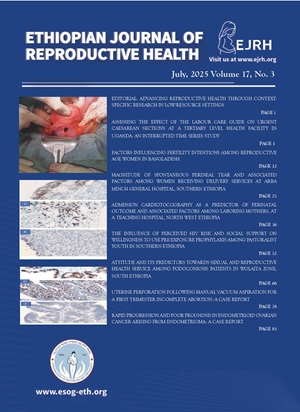Assessing the Effect of the Labour Care Guide on Urgent Caesarean Sections at a Tertiary Level Health Facility in Uganda: An Interrupted Time Series Study.
DOI:
https://doi.org/10.69614/ejrh.v17i3.930Keywords:
Labour, Labour Care Guide, Caesarean Section rate, Interrupted Time Series, Uganda, low-middle resource setting.Abstract
Background: The Labour Care Guide (LCG) has numerous benefits, including providing respectful care during labour and childbirth, and reducing the rate of urgent caesarean sections. However, there is limited literature on the effects of the LCG in low- and middle-income settings in Africa. This study aimed to evaluate the impact of implementing the LCG on urgent caesarean section rates in a low-resource, tertiary health facility in Uganda.
Methods: This Interrupted Time Series study (ITS) involved a retrospective review of medical records of pregnant women between July 1st 2021, and June 30th 2023. Data was collected from pregnant women admitted in labour and monitored using the modified WHO Partograph or the WHO Labour Care Guide at St. Francis Hospital Nsambya. Analysis was done using STATA 17/MP, with Continuous variables presented as means ± SD and proportions for categorical variables. Linear segmental regression was used to analyse the outcome data, with a significance level set at ? 0.05.
Results: A total of 2451 pregnant women were included in the study, with no significant differences between the two groups monitored during labour. The ITS model showed a significant decrease in urgent caesarean section rates (0.80, p-value 0.016) immediately after the introduction of the LCG, with no significant change in the slope post-intervention (0.015, p-value 0.053). From the aggregated data, the LCG accounted for a 14.0% [95% CI: 17.2 – 10.8] risk difference in urgent caesarean section deliveries and an odds ratio (OR = 0.44 [95% CI: 0.36-0.53], p-value <0.00. However, the study found no statistically significant difference in maternal complications or newborn outcomes immediately after delivery between the two labour monitoring tools (p-value > 0.05).
Conclusion and Recommendation: This study highlights a significant reduction in urgent caesarean section rates following the implementation of the WHO Labour Care Guide. The adoption of the labour care guide is recommended as a reliable method for decreasing urgent caesarean sections in Uganda.
References
Batist J. An intersectional analysis of maternal mortality in Sub-Saharan Africa: a human rights issue. J Glob Health [Internet]. 2019 [cited 2024 May 31];9(1). Available from: /pmc/articles/PMC6551548/
Musarandega R, Nyakura M, Machekano R, Pattinson R, Munjanja SP. Causes of maternal mortality in Sub-Saharan Africa: A systematic review of studies published from 2015 to 2020. J Glob Health [Internet]. 2021 [cited 2024 May 31];11. Available from: /pmc/articles/PMC8542378/
CHAMPIONING MATERNAL HEALTH: THE SAFE MOTHERHOOD CHALLENGE. - Ministry of Health | Government of Uganda [Internet]. [cited 2024 May 31]. Available from: https://www.health.go.ug/2023/10/19/championing-maternal-health-the-safe-motherhood-challenge/
Essential Maternal and Newborn Clinical Care Guidelines for Uganda, May 2022 | MOH Knowledge Management Portal [Internet]. [cited 2024 May 31]. Available from: http://library.health.go.ug/sexual-and-reproductive-health/essential-maternal-and-newborn-clinical-care-guidelines-uganda-may
Hussein AI, Kurtay S, Omar AA, Yusuf AA, Mohamud RYH. An Analysis of the Rate, Indications, and Associated Maternal Mortality for Cesarean Sections at a Tertiary Care Hospital, First Report from Somalia. Int J Womens Health [Internet]. 2023 [cited 2024 May 31]; 15:225. Available from: /pmc/articles/PMC9930581/
WHO Statement on Caesarean Section Rates.
Betran AP, Torloni MR, Zhang J, Ye J, Mikolajczyk R, Deneux-Tharaux C, et al. What is the optimal rate of caesarean section at population level? A systematic review of ecologic studies. Reprod Health [Internet]. 2015 Jun 21 [cited 2024 Feb 11];12(1):1–10. Available from: https://reproductive-health-journal.biomedcentral.com/articles/10.1186/s12978-015-0043-6
Pandey D, Bharti R, Dabral A, Khanam Z. Impact of WHO Labor Care Guide on reducing cesarean sections at a tertiary center: an open-label randomized controlled trial. AJOG global reports [Internet]. 2022 Aug 1 [cited 2024 May 31];2(3). Available from: https://pubmed.ncbi.nlm.nih.gov/36276791/
Atuheire EB, Opio DN, Kadobera D, Ario AR, Matovu JKB, Harris J, et al. Spatial and temporal trends of cesarean deliveries in Uganda: 2012-2016. BMC Pregnancy Childbirth [Internet]. 2019 Apr 16 [cited 2024 May 31];19(1):1–8. Available from: https://bmcpregnancychildbirth.biomedcentral.com/articles/10.1186/s12884-019-2279-6
Ghulaxe Y, Tayade S, Huse S, Chavada J. Advancement in Partograph: WHO’s Labor Care Guide. Cureus [Internet]. 2022 Oct 13 [cited 2024 Jun 5];14(10). Available from: /pmc/articles/PMC9652267/
Vogel JP, Pingray V, Althabe F, Gibbons L, Berrueta M, Pujar Y, et al. Implementing the WHO Labour Care Guide to reduce the use of Caesarean section in four hospitals in India: protocol and statistical analysis plan for a pragmatic, stepped-wedge, cluster-randomized pilot trial. Reprod Health [Internet]. 2023 Dec 1 [cited 2024 May 31];20(1). Available from: /pmc/articles/PMC9862839/
Betran AP, Torloni MR, Zhang J, Ye J, Mikolajczyk R, Deneux-Tharaux C, et al. What is the optimal rate of caesarean section at population level? A systematic review of ecologic studies. Reprod Health [Internet]. 2015 Jun 21 [cited 2024 May 31];12(1):57. Available from: /pmc/articles/PMC4496821/
R. MG, K. BJ, Wilson T, C. AE, Fajardo YT. Customization and acceptability of the WHO labor care guide to improve labor monitoring among health workers in Uganda. An iterative development, mixed method study. PLOS Global Public Health [Internet]. 2024 May 13 [cited 2024 May 31];4(5): e0002780. Available from: /pmc/articles/PMC11090317/
Penfold RB, Zhang F. Use of interrupted time series analysis in evaluating health care quality improvements. Acad Pediatr [Internet]. 2013 Nov [cited 2024 Jan 26];13(6 Suppl). Available from: https://pubmed.ncbi.nlm.nih.gov/24268083/



